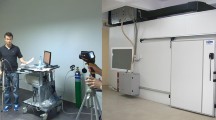Summary
Different methods of quantifying thermal alliesthesia were used to examine the circadian variations of thermal comfort. At eight different times of the 24 h day, four subjects were exposed to a constant room temperature of 25°C. After 30 min rest, the subjects performed 50 W bicycle ergometer work for 45 min. A 5 s temperature stimulus of 15°, 20°, 25°, 30°, 35°, and 38°C was applied on the hand, forehead, and back of the neck. For each stimulus the subjects voted their degree of thermal comfort on the subjective thermal comfort scale, ranging from +2 for very pleasant to −2 for very unpleasant. The most pleasant temperature on the back of the neck was chosen by voluntary control. This procedure was performed at the start and repeated every 15 min throughout the exposure time. A 5:5 × 2.7 cm2 Peltier thermode was used to give the temperature stimuli. Voluntary control voting was carried out using the temperature control knob without looking at the temperature scale of the thermode.
The results suggest that during rest in a state of thermal neutrality the core temperature is about 0.06°C lower than the thermoregulatory set point (Cabanac et al. 1976; Strempel et al. 1976). This deviation (Trect - Tset) from the set point is known in man-made servo-systems as the load error (Benzinger 1979). During rest in an atmosphere of thermal comfort, the “load error” in the human thermostat is found to be negative (Cabanac et al. 1976; Strempel et al. 1976; Benzinger 1979), i.e., Tset > Trect, where Trect is the prevailing core temperature and Tset, is the thermoregulatory set point. The small deviation from the set point is viewed as being necessary to sustain the response and to keep the temperature in equilibrium between production and loss of heat (Benzinger 1979). Thermal comfort limits during work rise from the early morning to the afternoon and then fall slowly towards the minimum level in the morning. The circadian variations of the core temperature load error associated with onset of sweating have a phase shift of 180° (12 h) with the alliesthesial reactions. Using our results and the results from Cabanac et al. (1976), it has been possible to write a circadian thermoregulatory set function to estimate the set point at any point of day time.
Similar content being viewed by others
References
American Society of Heating, Refrigerating and Air-Conditioning Engineers (1966) Thermal comfort conditions. ASHRAE Standard, New York, pp 55–66
Aschoff J, Heise A (1972) Thermal conductance in man: its dependence on the time of day and on ambient temperature. In: Ito P, Ogata K, Yoshimura H (eds) Advances in climatic physiology. Igaku Shoin, Tokyo, pp 334–348
Benzinger TH (1979) The physiological basis for thermal comfort. In: Fanger PO, Valbjørn O (eds) Indoor climate. Danish Building Institute, Copenhagen, pp 441–476
Cabanac M (1969) Plaisir ou deplaisir de la sensation thermique et homothermie. Physiol Behav 4:359–364
Cabanac M, Cunningham DJ, Stolwijk JAJ (1971) Thermoregulatory set point during exercise. J Comp Physiol Psychol 76:94–102
Cabanac M, Massonnet B, Belaiche R (1972) Preferred skin temperature as a function of internal and mean skin temperature. J Appl Physiol 33:699
Cabanac M, Hildebrandt G, Massonnet B, Strempel H (1976) A study of the nycthemeral cycle of behavioural temperature regulation in man. J Physiol 257:275–291
Engel P, Gründl R, Attia M (1979) Thermal stress/strain investigations in work places using comfort/discomfort criteria. Work report no. 1, European Coal and Steel Community, Luxembourg
Fanger PO, Hojbjerre J, Thomsen JOB (1973) Man's preferred ambient temperature during the day. Arch Sci Physiol 27:4
Gagge AP, Gonzalez RR, Nishi Y (1974) Physiological and physical factors governing man's thermal comfort, discomfort and heat tolerance. In: Build International 7: 305–331. Applied Science Publishers, London
Hatch TF (1967) Heat control in hot industries. In: Patty FA (ed) Industrial hygiene and toxicology, Vol 1, 21. Interscience Publishers, London New York Sydney, pp 789–807
Hensel H, Brück K, Raths P (1973) Homothermic organisms. In: Precht P, Christophersen J, Hensel H (eds) Temperature and life. Springer, Berlin Heidelberg New York
Hensel H, Beste R, Kaiser K (1977) Thermische Adaptation am Menschen. In: Arbeitsberichte des Sonderforschungsbereiches Adaptation and Rehabilitation (SFB 122) der Univ Marburg/Lahn, 4:133–153
Hensel H, Beste R, Kaiser K (1978) Thermische Adaptation am Menschen. In: Arbeitsberichte des Sonderforschungsbereiches Adaptation und Rehabilitation der Universität Marburg/Lahn, 5:58–71
Hildebrandt G, Engelbertz P (1953) Bedeutung der Tagesrhythmik für die physikalische Therapie. Arch Phys Ther 5:160–170
Hildebrandt G (1974) Circadian variations of thermoregulatory response in man. In: Cheving LE (ed) Chronobiology. Igaku Shoin, Tokyo, pp 234–240
Lambert G (1977) L'adaptation physiologique et psychologique de l'homme aux conditions de vie désertique. Hermann, Paris 1968. In: Rutenfranz J, et al Biomedical and psychological aspects of shift work. Scand J Work Environ Health 3:165–182
Strempel H, Hildebrandt G, Cabanac M, Massonnet B (1976) Tagesrhythmische Einflüsse auf die Thermoregulation unter thermischen Belastungen. In: Hildebrandt G (Hrsg) Biologische Rhythmen und Arbeit. Springer, Wien New York
Voigt ED, Engel P (1969) Diurnal variations of energy consumption during work. Arch Ges Physiol 307:89
Author information
Authors and Affiliations
Rights and permissions
About this article
Cite this article
Attia, M., Engel, P. & Hildebrandt, G. Thermal comfort during work. Int. Arch Occup Environ Heath 45, 205–215 (1980). https://doi.org/10.1007/BF00380784
Received:
Accepted:
Issue Date:
DOI: https://doi.org/10.1007/BF00380784




